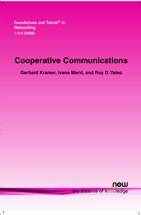Cooperative Communications
By Gerhard Kramer, Bell Laboratories, USA, gkr@bell-labs.com | Ivana Marić, Dept. of Electrical Engineering, Stanford University, USA, ivanam@systems.stanford.edu | Roy D. Yates, WINLAB, Rutgers University, USA, ryates@winlab.rutgers.edu
Abstract
This article reviews progress in cooperative communication networks. Our survey is by no means exhaustive. Instead, we assemble a representative sample of recent results to serve as a roadmap for the area. Our emphasis is on wireless networks, but many of the results apply to cooperation in wireline networks and mixed wireless/wireline networks. We intend our presentation to be a tutorial for the reader who is familiar with information theory concepts but has not actively followed the field. For the active researcher, this contribution should serve as a useful digest of significant results. This article is meant to encourage readers to find new ways to apply the ideas of network cooperation and should make the area sufficiently accessible to network designers to contribute to the advancement of networking practice.
Cooperative Communications
Cooperative Communications reviews progress in cooperative communication networks. It assembles a representative sample of recent results to serve as a roadmap for the area. The emphasis is on wireless networks, but many of the results apply to cooperation in wireline networks and mixed wireless/wireline networks. Cooperative Communications is intended as a tutorial for the reader who is familiar with information theory concepts but has not actively followed the field. For the active researcher, it serves as an invaluable digest of significant results. It is designed to encourage readers to find new ways to apply the fundamental ideas of network cooperation. It is also intended to make the area sufficiently accessible to practicing network designers.
